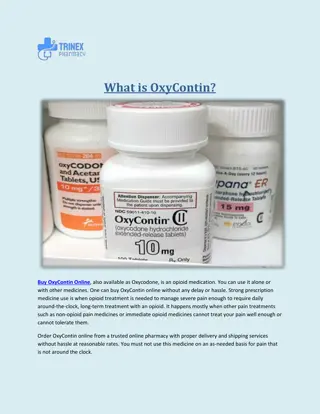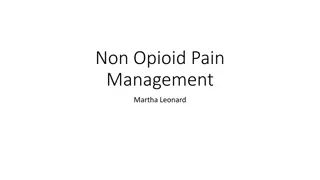Addressing the Opioid Crisis in Cumberland County, Pennsylvania
Cumberland County, Pennsylvania, faced a significant increase in opioid-related deaths and criminal dockets. To combat this crisis, an Opioid Intervention Court was established in 2018, following the Buffalo model. The court's structure, team composition, and response highlight a collaborative effort to address the opioid epidemic through tailored interventions and support services.
Download Presentation

Please find below an Image/Link to download the presentation.
The content on the website is provided AS IS for your information and personal use only. It may not be sold, licensed, or shared on other websites without obtaining consent from the author.If you encounter any issues during the download, it is possible that the publisher has removed the file from their server.
You are allowed to download the files provided on this website for personal or commercial use, subject to the condition that they are used lawfully. All files are the property of their respective owners.
The content on the website is provided AS IS for your information and personal use only. It may not be sold, licensed, or shared on other websites without obtaining consent from the author.
E N D
Presentation Transcript
Opioid Intervention Court Cumberland County, Pennsylvania
The Problem In 2016, 13 Pennsylvanians died daily due to opioids The epidemic is the leading cause of death for people under age 50 Between 2015-2016, most counties saw a 37% increase in deaths related to drug poisoning Cumberland County saw a 61% increase in fatalities in that time period
The Problem Between 2011 and 2015, there was a 200% increase in the number of inmates placed on medical detox from opiates upon commitment to CCP The Sentinel identified individuals with recent criminal charges made up nearly 60% of all overdose deaths in the county in 2015 These same individuals were 110 times more likely to die of an overdose that year than those without recent charges
The Problem Cumberland County experienced a 25% increase in criminal dockets filed between 2015 and 2017 (+1000 cases) The average daily population at the Cumberland County Prison increased from 400 to 460 during the same time period.
A Response Administrative Office of Pennsylvania Courts (AOPC) approached Cumberland County to start an opioid court based on the Buffalo model. Funding $200K from AOPC $150K from PA Commission on Crime & Delinquency
Arrest Preliminary Arraignment Magisterial District Justice Summons Bail Jail Preliminary Hearing Formal Arraignment Court of Common Pleas Pretrial Conference Trial
Opioid Intervention Court Started February 26, 2018 Team Judge Coordinator Assistant District Attorney Public Defender Program Manager Drug & Alcohol Case Manager Jail 3 Certified Recovery Specialists 2 Restorative Sanctions Assistants 2 Adult Probation & Parole Officers
The Process LEOs and MDJs identify defendants based on charges or other information MDJ sets OIC screening bail condition Jail: review booking documents, and/or review detox list Bail: report to OIC next business day Summons: report to Public Defender next Wednesday at 1:30 pm
Screening - Community Acknowledgement form Outlines basic conditions of program Select to pursue OIC with PD or private attorney Select to decline OIC Texas Christian University (TCU) Drug Screen 5 Opioid Supplement Personal Information Form Urine Drug Screen
Screening - Community Observe OIC Bail modification hearing
Screening - Jail Acknowledgement Form TCU 5 w/Opioid Supplement Personal Information Form Develop treatment plan Vivitrol program, drug and alcohol evaluation Develop approved home plan Resolve warrant and detainers Video bail modification hearing
Program Eligibility Pre-plea Adult defendant with pending misdemeanor or felony charge(s) Cumberland County resident Some minor exceptions Substantiated opioid substance-use disorder District Attorney has veto authority Generally drug dealer or felony crime of violence
The Program 30 days consecutive court appearances Frequent drug testing Daily treatment/recovery activity Treatment LOC, self-help group meeting, RASE recovery group 1x week, other counseling Engaged in RASE recovery plan Nightly curfew 8:00 pm 8:00 am Monitored with BI SmartLink phone app
The Program Daily routine 8:00 am: defendants report to Restorative Sanctions in courthouse basement to sign in and drug test if selected 8:45 am: drug testing wraps up and team meets for mini-staffing prior to court 9:00 am (-ish): court begins and each defendant goes before judge Team staffing is Monday following court
The Program Defendants awarded completion certificate at end of active phase Step down to continuing care phase until case disposition Appear 1 x weekly Continue treatment level of care Continue self-help group meetings Continue RASE recovery plan
The Program Case disposition goals Have offer ready and enter guilty plea at completion of active phase Set sentencing date for a sufficient period of continuing care Defendants who successfully complete active and continuing care phases see significant reduction in sentencing
Stuff Happens Sanctions Opioid use: jail, revocation Other drug use: recovery assignment, days added, house arrest/EM, jail, revocation Other violations: recovery assignment, days added, sit in penalty box, increase appearances, jail, revocation New offense/abscond: jail, revocation
The Results Admitted .93 Active ...12 Continuing Care .12 Jail/Treatment 0 Bench Warrant ..1 Successful ..38 Revoked Active ..14 Revoked Continuing Care 14 Other disposition .2 In-program re-offending .4 Post-program re-offending . 1 Pipelined to Treatment Court .12 Pipelined to TOMS Court 2 Deaths .0























